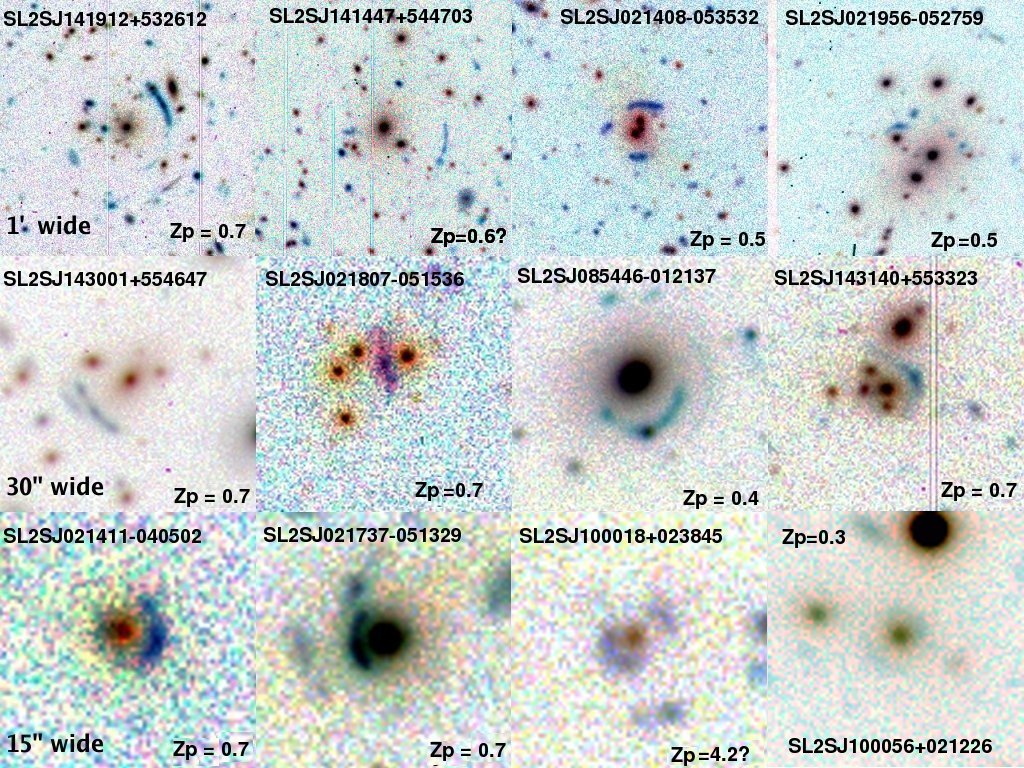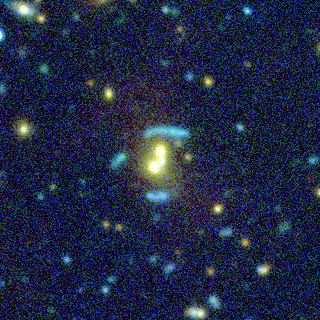
This mosaic shows a subset of the sample of new gravitational lenses discovered in the CFHTLS and illustrating the broad range of masses probed by the excellent images gathered at CFHT.
In addition to the very massive clusters and compact galaxies, a large number of intermediate mass lenses are seen for the first time.
© Canada-France-Hawaii Telescope Corporation 2006

This example of a galaxy group lens in the CFHTLS-SL2S,
called SL2SJ021408-053532, shows a very complex arc structure (in
blue).
Such
complex arc geometries allow us to probe the details of the dark matter
profiles
associated with the group of yellow galaxies in the center of the
image.

This is a spectacular example of giant arcs around a massive
cluster
galaxy (SL2SJ085446-012137).
Such multiple arc configurations are rare and very
powerful to probe the substructures of dark matter within large
clusters.
The small white spot on top of the bright blue arc is actually a
satellite galaxy
inducing its own distortion on the arc. Such a unique configuration
imposes very
strong constraints on the offset between luminous and dark matter.

This very bright ringlet configuration (SL2SJ021737-051329)
is actually a group of multiple images of a single source, called cusp
arcs,
merged together in a single arc on the ground-based images.
High resolution images from space telescopes, free of atmospheric
distortions,
are required to discriminate the individual images.
Such strongly magnified
rings are especially important for the study of the evolution of dark
matter with
time and allow astronomers to study instrinsically faint sources using
the
lens as a "gravitational telescope".

Abel 370 in 1985
This picture if the first image of a giant gravitational arc,
found in a massive nearby cluster calleb Abel 370.
This image has been taken in 1985 at CFHT through an R filter, using
the first CCD camera made available to the observers at the
observatory. Called RCA1, this camera boosted a matrix of 320x512
pixels (!) with a resolution of 0.8 arcsecond/pixel.
This image introduced the astronomers to the rich realm of strong
gravitational lensing of galaxies by massive foreground clumps of dark
matter.
It first appeared in January
1987, 20 years ago, in the following article:
Soucail, G., Fort, B., Mellier, Y., & Picat, J. P. 1987, Astronomy
and Astrophysics A
blue ring-like structure, in the center of the A 370 cluster of galaxies
The gravitational lensing origin of the arc was recognized ten
months later in:
Soucail, G., Mellier, Y., Fort, B., Mathez, G., & Hammer, F. 1987,
Astronomy and Astrophysics Further
data on the blue ring-like structure in A 370

Abel 370 in 1990
Taken five years later with the camera RCA2, this image illustrates the
rapid progress of the CCD technology in a short time, ending with
today's mosaics like MegaCam and its 340 MegaPixels...
Here is the same image with a slightly higher resolution

The Canada-France-Hawaii telescope structure is based on an equatorial
mount design, with one of the axis of rotation set parallel to the axis
of the Earth¹s rotation. The mirror cell (the white circular
structure
at the bottom of the telescope, seen just above the person giving the
scale
on this photograph) holds and protects the most precious element: the
3.6-meter
diameter mirror.
Light from distant objects enters the dome through
the slit, bounces back from the mirror such that it will focus, and
create
a crisp image at the prime focus, MegaPrime, where the image is
captured
by MegaCam, CFHT's
wide-field digital camera (340 MegaPixels!) .
By today's standards, the CFHT telescope is a heavy
structure compared to the diameter of its mirror: the total mass of the
telescope is 325 tons, with 250 tons for the mobile section alone. Yet
the telescope can point to any location in the sky with an accuracy of
3 thousandths of a degree - and can follow astronomical objects with an
even better accuracy, thanks to an automated guiding mechanism that
compensates
for the apparent motion of the sky due to the Earth's rotation.